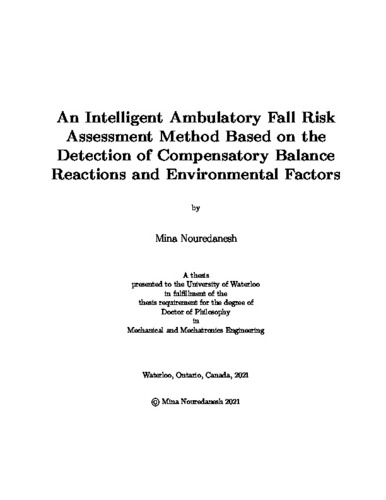| dc.description.abstract | Falls in older adults are a critical public health problem worldwide and impact one in three older adults at least once each year. In addition to physical consequences (e.g., hip fracture) falls can lead to negative psychological outcomes, such as depression.
Fall risk assessment (FRA) is the initial step for fall prevention programs and interventions. In particular, clinicians aim to understand what factors put older adults at high risk of falling to inform the selection and timing of fall prevention interventions (e.g., strengthening programs). These risk factors are generally categorized as intrinsic or biological (e.g., gait and balance disorders) and extrinsic or environmental (e.g., slippery surfaces). While supervised FRAs, including performance-based (e.g., Timed up and Go) and instrumented methods (e.g., motion capture systems), capable of quantifying intrinsic risks have advanced significantly, falls still remain a major priority in geriatric medicine and public health. This can be due to the Hawthorne effect, the heterogeneous nature of older adults' health, lifestyle, and behaviors, and the complex, multifactorial etiology of falls. To address the limitation of supervised FRAs, a growing body of literature has focused on wearable sensor-based methods for free-living (or ambulatory) FRA. These studies, reviewed in Chapter 2, investigated the relationships between free-living digital biomarkers (FLDBs) extracted from wearable sensors data (generally, inertial data) and the frequency of prospective/retrospective falls in older adults. However, many FLDBs exhibited inconsistent fall predictive powers across studies, indicating they may not be stable in distinguishing fall-prone individuals. Moreover, the relationships between falls and free-living dynamic postural control measures, such as step width and the frequency of naturally-occurring compensatory balance reactions (CBRs), have yet to be investigated in depth. Considering controlled studies reported balance impairment as one of the strongest risk factors for falls, the investigation of balance-related FLDBs may lead to more stable risk assessments and provide new insights into fall prevention in older adults.
Although gait-related FLDBs extracted from inertial data can be impacted by both intrinsic and environmental factors, their respective impacts have not been differentiated by the majority of free-living FRA methods. This may lead to the ambiguous interpretation of the subsequent FLDBs, and less precise intervention strategies to prevent falls. A context-aware free-living FRA would elucidate the interplay between intrinsic and environmental risk factors and clarifies their respective impacts on fall predictive powers of FLDBs. This may subsequently enable clinicians to target more specific intervention strategies including environmental modification (e.g., eliminating tripping hazards) and/or rehabilitation interventions (e.g., training to negotiate stairs/transitions).
This doctoral thesis aims to address the aforementioned research gaps by proposing multiple machine learning frameworks and incorporating an egocentric camera along with wearable inertial measurement units (IMUs). Chapter 3 discusses the development of random forest models to differentiate between normal gait episodes and multidirectinoal CBRs (e.g, slip-like, trip-like, sidestep) elicited by a perturbation treadmill in controlled conditions in healthy young adults, where the CBR detection model achieved the overall accuracy of ~96%. This chapter established the infrastructure for Chapter 4, where a validation study was performed to detect older adults' CBRs under free-living conditions. Random forest models were trained on independent/unseen datasets curated from multiple sources, including perturbation treadmill CBRs. By investigating 11 fallers' and older non-fallers' free-living criterion standard data, 8 naturally-occurring CBRs, i.e., 7 trips (self-reported using a wrist-mounted voice-recorder) and 1 hit/bump (verified using egocentric vision data) were localized in the corresponding trunk-mounted IMU data. A subset of models differentiated between naturally-occurring CBRs and free-living activities with high sensitivity (100%) and specificity (~99%) suggesting that accurate detection of naturally-occurring CBRs is feasible. Moreover, to address the limitations of IMUs in terms of the estimation of step width in free-living conditions, Chapter 5 presents a novel markerless deep learning-based model to obtain gait patterns by localizing feet in the egocentric vision data captured by a waist-mounted camera.
With the aim of improving the interpretability of gait-related FLDBs and investigating the impact of environment on older adults' gait, Chapter 6 proposes a vision-based framework to automatically detect the most common level walking surfaces. Using a belt-mounted camera and IMUs worn by fallers and non-fallers (mean age 73.6 yrs), a unique dataset was acquired (a subset of Multimodal Ambulatory Gait and Fall Risk Assessment in the Wild (MAGFRA-W) dataset). A series of ConvNets were developed: EgoPlaceNet categorizes frames into indoor and outdoor; and EgoTerrainNet (with outdoor and indoor versions) detects the enclosed terrain type in patches. EgoPlaceNet detected outdoor and indoor scenes in MAGFRA-W with 97.36% and 95.59% (leave-one-subject-out) accuracies, respectively. EgoTerrainNet-Indoor and -Outdoor achieved high detection accuracies for pavement (87.63%), foliage (91.24%), gravel (95.12%), and high-friction materials (95.02%), which indicate the models' high generalizabiliy.
Overall, promising results encourage the integration of wearable cameras and machine learning approaches to complement IMU-based free-living FRAs, towards stable context-aware FLDBs for fall prevention in older adults. Implications for further research to examine the relationships between naturally-occurring CBRs and fall risk, and clinical applications are discussed. | en |

